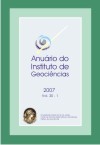The foot posture of Protolipterna ellipsodontoides Cifelli, 1983 (Mammalia: Litopterna: Protolipternidae) of São José de Itaboraí Basin, Rio de Janeiro (late Paleocene)
DOI:
https://doi.org/10.11137/2007_1_58-66Abstract
The Litopterna is a group of endemic South America ungulates that lived from Late Paleocene (Itaboraiense) to Late Pleistocene (Lujanense). The order is divided in two large groups based on dental features: the Bunolipterna, in which the Protolipternidae is placed, is composed by taxa with primitive bunodont teeth; and the Lopholipterna, grouping taxa with derived lophodont teeth. In both the postcranial morphology is derived and uniform since the early forms. The Itaborai Basin, located at São José district, Itaboraí city, Rio de Janeiro state, is filled with different kinds of limestones, cut vertically by fissure fill deposits, where most of the fossils were collected. Protolipterna ellipsodontoides was described in 1983 based on dental features, but later postcranial bones were associated to this species. The main goal of this article is to infer the foot posture of P. ellipsodontoides. The material studied consists of femora, astragali, calcanea and metatarsals III, comprising 165 bones. All fossils were deposited in the fossil mammal collection of Departamento Nacional da Produção Mineral, in Rio de Janeiro state, Brasil. The methodology employed consisted of 15 linear and curvilinear measurements, which were submitted to a multivariate analysis (Principal Component Analysis -PCA and Discriminant Function Analysis -DFA). The results suggested a digitigrade posture to P. ellipsodontoides. Other morphological features of the skeleton, associated with a digitigrades posture, are suggestive of a cursorial locomotion, but with probable saltatory habits.Downloads
Download data is not yet available.
Downloads
Published
2007-01-01
How to Cite
Bastos, A. C. F. and Bergqvist, L. P. (2007) “The foot posture of Protolipterna ellipsodontoides Cifelli, 1983 (Mammalia: Litopterna: Protolipternidae) of São José de Itaboraí Basin, Rio de Janeiro (late Paleocene)”, Anuário do Instituto de Geociências. Rio de Janeiro, BR, 30(1), pp. 58–66. doi: 10.11137/2007_1_58-66.
Issue
Section
Article
License
This journal is licensed under a Creative Commons — Attribution 4.0 International — CC BY 4.0, which permits use, distribution and reproduction in any medium, provided the original work is properly cited.















